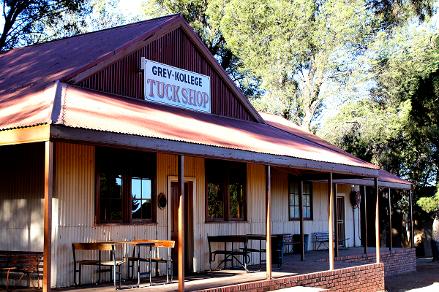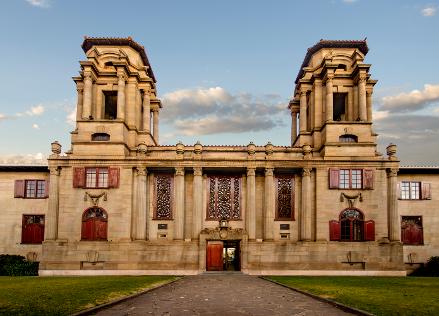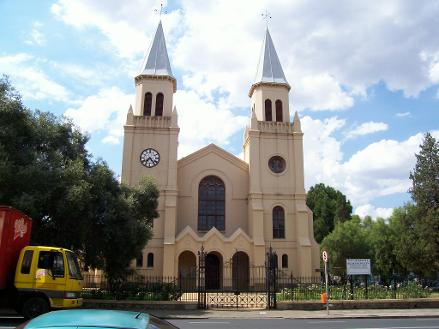National Parks Nature Reserves Nelspruit Pietersburg Port Elizabeth Pretoria Regions Routes Rustenburg Towns West Coast
Historical Sights
(Bloemfontein / Mangaung, Free State)
Historical Sights to See:
Anglican Cathedral
This
cathedral is regarded as the spiritual heart of Bloemfontein and it’s
foundation stone was laid in 1850 by the city’s founder, Major Henry
Douglas Warden. The interior décor epitomises graceful elegance and the
beautiful windows are classical Victorian.
Bloemfontein City Hall
Impressive
sandstone building designed by Sir Gordon Leith. It is located in
President Brand Street, which has been declared a National Conservation
Area in it’s entirety.
Court of Appeal
The
Raadsaal is faced by the Court of Appeal, the highest court in the
country. The stinkwood paneled courtroom itself is the most magnificent
in South Africa while the Judges’ Library adds dignity to the already
impressive building. The first sitting of this Court of Appeal took
place on 4 June 1910.
Fourth Raadsaal
Free State Agricultural Museum
This
living agricultural museum depicts farming activities which take place
on a daily basis and represents various aspects of farming culture which
have been preserved for future generations.
Free State Education Museum
The
museum serves as an archive for the Education Department, and can be
visited by appointment only. The museum was opened on 26 April 1986.
Freshford House Museum
Freshford was built in 1897 by the architect, John Edwin Harrison, and
belonged to him and his wife, Kate Caroline Marchant, until 1902. The
house has been restored by the National Museum and furnished as a house
museum.
Hertzog Square
Opposite
the City Hall in Hertzog Square. The imposing monument dedicated to
General JBM Hertzog comprises a statue with fountains. Sculptor Danie de
Jager
Jukskei Museum
This
museum, the only of it’s kind in the world, presents the origin and
development of the one true South African sport practiced in several
parts of the world – Jukskei. Visit by appointment only.
National Museum
The museum houses the most extensive collection of fossil and archaeological material in South Africa, including a reconstruction of the Florisbad Skull
National Museum for Afrikaans Literature, Theatre and Music
National Women’s Memorial & War Museum
At a commanding site near the south end of Monument Road is the national Women’s Monument, a celebrated example of South African Sculpture art, created by Anton van Wouw. This sandstone shrine of 36,5 m in height was erected in memory of the women and children who lost their lives during the Anglo Boer War (1899 – 1902). Emily Hobhouse, the ‘turncoat’ heroine who drew the world’s attention to the appalling conditions in the concentration camps, is also buried here.
Oliewenhuis Art Museum
This Neo Cape Dutch manor house was originally erected to house the Governors General and later State Presidents during their visits to Bloemfontein. The house was largely under-utilised, and was handed over to the National Museum in 1985 to function as an Art Museum.
President Brand Cemetery & President’ Acre
Opposite the Old Fort is the President Brand Cemetery, where many men, women and children who lost their lives in the Anglo Boer War (1899 – 1902) are buried. The President’s Acre in President Avenue is the last resting place of former State Presidents.
Queen’s Fort – Military Museum
In Church Street, on the brow of the hills the Old Fort was erected during 1848 as a strongheld against native raids. Near the entrance is a monument to the memory of the burgers who fell in the Basotho War. The museum depicts all conflicts in the Free State from 1820 – 1990.
Rugby Museum
One of the largest private rugby collections in the world.
SA Armour Museum
This museum deals specifically with the military area of armour. It consists of an indoor and outdoor area and a reference library.
Supreme Court
The Supreme Court opposite the Fire Brigade in President Brand Street is the seat of the Provincial Law Courts. The magnificent interior warrants a visit. Civil, as well as criminal cases from all over the Free State are heard here. It was built during 1909 at a cost of 60 000 pounds
The First Raadsaal
Turning into St Georges Street, the visitor comes to a humble, one roomed building, with thatched roof and dung smeared floor. This is the Old Raadsaal erected by Major Warden during 1849. It is indeed unique, for it has housed in succession nearly every civilian institution, church, conference chamber, parliament house, school and museum, a record as strange as it is honorable.
The Fountain
The concrete column and city emblem in mosaic are the symbols of the fountain from which Bloemfontein got it’s name.
The Fourth Raadsaal
The Raadsaal, the last home of the ‘Model’ Free State Republican Parliament is an impressively designed edifice in the classical style. The building was completed in 1893 the architect being L Canning, the builder JH Robertson. The original benches used by the Volksraad still remain. The busts of the six presidents adorn the walls, while behind the seat of the chairman hangs the original Coat of Arms of the Free State, beautifully carved in wood. Facing the Raadsaal is the Court of Appeal.
The Old Presidency
Diagonally opposite the Magistrate’s Court stands a lovely Victorian house museum, dating back to the era of the Presidents of the former Republic of the Orange Free State.
The White Horse
Located on the slopes of Naval Hill, this horse was laid out during the Anglo Boer War (1899 – 1902) by the men of the Wiltshire Remount Depot as a landmark for horsemen riding in from the plains.
Twin Spired Church
This
is the only twin spired Dutch Reformed Church in the country. Completed
in 1880. The last three presidents of the Free State Republic took the
oath of office here.
Unit Museum – 1 Special Service Battalion
This special battalion was born out of grim circumstances and despair of the Great Depression, to save the youth from the loss of self confidence and the risk of moral and physical degeneration caused by massive and prolonged unemployment at the time. Articles in the museum date back to the year 1933.
War Museum
Adjacent to the National Women’s Memorial, the museum gives insight into the Anglo Boer War through it’s art collection, dioramas and exhibits.
Abraham Fischer Mens Hostel:
The building was designed by Frank Taylor and was officially opened on 16 October 1909 by the then Prime Minister of the Orange River Colony, Abraham Fischer. The men's hostel and the main building were the first to be erected on the site of the former Grey University College, and now form the historic core of the University of the Free State. It was declared a National Monument under old NMC legislation on 27 December 1985.
Main Building:
The cornerstone of the building was laid on 19 December 1907 by Sir Hamilton Gould-Adams, and was officially opened on 16 October 1909. The north and south wings date from 1915 and 1929 respectively. It was declared a National Monument under old NMC legislation on 7 October 1983.
Grey-College
Main Building, Houses Brill & Andrew Murray , and Tuck Shop:
These three buildings form the historical core of Grey College, the oldest school in the Free State.
Brill House and Andrew Murray House were designed by Frank Taylor, and were officially opened on 19 December 1907 by the then Governor of the Orange River Colony, Sir Hamilton J Gould-Adams. The tuckshop probably dates to 1908 and has been a popular gathering place for pupils of Grey College ever since. It was declared a National Monument under old NMC legislation on 7 March 1986.
Giant White Horse:
This
flat topped hill rising from the heart of Bloemfontein is internationally known for it's giant white horse painted on the side of the hill, visible from 50km away and was originally a signal to the horse-riders of the Wiltshire Remount Depot during British occupation. Naval hill offers
spectacular views of the city and surrounding areas.
Lamont Hussey Observatory:
This observatory has
been converted into a theatre, The Franklin Nature
Reserve is situated on Naval Hill.
Franklin Nature Reserve
This nature reserve is one of the only nature reserves in the world that is situated in the heart of a city. This reserve of +/-200 ha is home to a variety of wild game species, including springbok, eland, red hartebeest, giraffe, gemsbok and blesbok.
Bloemfontein Technical College:
Also known as the Old Grey College building. The structure was designed by architect WH Stucke and was erected in 1894-95 by building contractor D Godley. Its foundation stone was laid on 16 May 1894 by President Reitz and the eastern and western wings were completed in 1895 and 1898 respectively. The building accommodated Grey College until 1907, was then used by the Normal College, and since 1932, by the Bloemfontein Technical College. On 1 July 1909 the South African Academy for Arts and Science was founded here. It was declared a National Monument under old NMC legislation on 29 June 1984.
Hoffman Square
The square lies between Maitland Street and St Andrew Street and houses the bus office and terminus. The square lies within walking distance of the railway station, the post office, the most important shops, business centre, hotels and places of entertainment. All buses on city routes depart from here and taxis are available from East Burger Street and the station.
State President Swart Park, King’s Park and Zoo
These
parks are the largest of the city’s many pleasure grounds. They are a
blaze of colour almost all year round. Bloemfontein is known as the City
of Roses and more than 4000 rose trees have been planted in the rose
garden in King’s Park. Within the area of King’s Park is the Zoo, where
an interesting collection of birds and animals are displayed in almost
natural surroundings. This zoo has the largest collection of primates
(apes) in South Africa. Altogether 16 different species are encountered
here.



